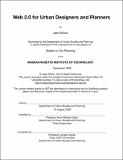Web 2.0 for urban designers & planners
Author(s)
Wilson, Jase (Jase C.)
DownloadFull printable version (4.151Mb)
Alternative title
Web two dot zero for urban designers and planners
Other Contributors
Massachusetts Institute of Technology. Dept. of Urban Studies and Planning.
Advisor
Anne Whiston Spirn.
Terms of use
Metadata
Show full item recordAbstract
The author contends that a class of new and emerging participatory Web-based tools, referred to at present as "Web 2.0," can and should be used by urban designers and planners to achieve better results in public participation exercises. A brief overview of the World Wide Web is given-how and why it came to be, where it is now, and a glimpse at where it's headed. Public participation is reviewed-reasons for it, some of the challenges faced in its practice, and a widely regarded, though seldom implemented model for achieving success with it, based on methods set forth by Christopher Alexander. Ways that Web 2.0 tools can be applied to overcome the common challenges, and ways they can be used to facilitate the model for success are identified. To show how such results can be attained in practice, a hypothetical scenario is constructed, in which a fictional planning team uses the full capabilities of Web 2.0 to facilitate public participation while authoring an area plan. The closing chapter identifies a short list of potential barriers to using the Web in public participation, and offers some ideas for dealing with each. The research draws from literature written on public participation in urban design and planning, and literature written about the World Wide Web. Interviews of experts from both areas were conducted. Existing and emerging Web 2.0 tools were analyzed, and a test of concept was constructed to prove it's easy to solicit public feedback using Web 2.0. This thesis lives on the Web, with comments enabled and welcome, at http://nmit.edu/jase/thesis. Keywords Collaborative, Design, Expertise, Internet, Knowledge, Language, Local, Making, Order, Organic, Participation, Participatory, Pattern, Place, Planning, Public, Site, Situated, Urban, Web 2.0, Web, Website, Wiki, World, WWW
Description
Thesis (M.C.P.)--Massachusetts Institute of Technology, Dept. of Urban Studies and Planning, 2008. This electronic version was submitted by the student author. The certified thesis is available in the Institute Archives and Special Collections. Includes bibliographical references (p. 101-108).
Date issued
2008Department
Massachusetts Institute of Technology. Department of Urban Studies and PlanningPublisher
Massachusetts Institute of Technology
Keywords
Urban Studies and Planning.